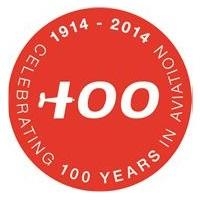Traces Aviation Legacy To 1914 With First Aircraft Stabilizer
Honeywell marked 100 years of innovation and leadership in the aerospace and oil and gas industries as Honeywell Chairman and CEO Dave Cote led other company executives in ringing the closing bell at the New York Stock Exchange. The bell ringing recognized the centennials of Honeywell Aerospace, a pioneer in aviation, and Honeywell’s UOP, which created the basis for the modern refining industry.

Honeywell Aerospace traces its legacy of innovation to June 18, 1914, when Lawrence Sperry did a “wing walk” with no one at the controls of his airplane to demonstrate the first aircraft stabilizer, which became known as the autopilot. Today, Honeywell has one of the largest aerospace products and services portfolios in the industry, having invented hundreds of technologies that have led to safer skies, space exploration and stronger military offerings. Honeywell offers thousands of products and services that can be found on virtually every commercial, defense and space aircraft worldwide.
UOP was founded in Chicago on June 17, 1914, to commercialize the first conversion technology for upgrading crude oil, resulting in a fourfold increase in the amount of gasoline that could be derived from crude oil.
For more than a century, Honeywell Aerospace has helped write aviation history, with a major focus on flight safety. “I’m proud to be part of a company that has accomplished so much, including the invention of the autopilot 100 years ago. We are just getting started, and we will continue to provide innovative aviation solutions that make the possibilities of flight even safer, more efficient, more comfortable, more productive and higher performing,” said Tim Mahoney, president and CEO, Honeywell Aerospace. “With the rapid pace of technology evolution, such as our work on wireless connectivity, Honeywell will be at the forefront of incredible aviation innovation in the coming decades that outshines the amazing things we’ve done this past century.”
Together with its legacy companies and in addition to the first autopilot, other Honeywell Aerospace inventions include:
- The first gyro horizon and directional gyro, invented in the 1920s, proved the practicality of instrument-only flight with advanced navigation.
- In the 1940s, technology inventions led to the advent of cabin pressurization, which enabled higher-flying aircraft and space exploration.
- The first gas turbine Auxiliary Power Unit (APU), invented in 1948, revolutionized commercial air travel to remote regions when it was first installed on the Boeing 727 in the 1960s, providing independent startup and backup power. The APU played a critical role in the emergency landing of US Airways Flight 1549 in New York’s Hudson River, ensuring the safety of 155 passengers onboard.
- The first Ground Proximity Warning System (GPWS) was invented in the 1970s and the Enhanced GPWS (EGPWS) in the 1990s have helped pilots avoid flying into unseen mountains and other terrain. The technologies have been credited with saving thousands of lives.
- The first complete 3-D picture of airborne weather conditions, Honeywell’s IntuVue weather radar, was developed in 2008. The technology helps increase in-flight pilot awareness and safety, while enhancing passenger comfort, by avoiding poor weather conditions and turbulence.
- Honeywell Aerospace continues to invest in research and technology and is committed to bringing to the industry the latest solutions in safety, connectivity, energy efficiency, air traffic management and more.
UOP became a wholly owned subsidiary of Honeywell in 2005. Since then, UOP’s revenue has more than doubled as Honeywell has invested in its growth.
“UOP has been and continues to be a driving force of innovation for the global petroleum and natural gas industries,” said Rajeev Gautam, president and CEO of UOP. “Our partnership with the world’s oil and gas companies has led to the development and commercialization of the technologies that have enabled our modern way of living.”
During the past 100 years, UOP breakthroughs include technologies to more efficiently produce gasoline, diesel fuel and jet fuel.
 Unfortunate... ANN/SportPlane Resource Guide Adds To Cautionary Advisories
Unfortunate... ANN/SportPlane Resource Guide Adds To Cautionary Advisories ANN FAQ: Turn On Post Notifications
ANN FAQ: Turn On Post Notifications ANN's Daily Aero-Term (04.29.24): Visual Approach Slope Indicator (VASI)
ANN's Daily Aero-Term (04.29.24): Visual Approach Slope Indicator (VASI) ANN's Daily Aero-Term (04.28.24): Airport Marking Aids
ANN's Daily Aero-Term (04.28.24): Airport Marking Aids ANN's Daily Aero-Linx (04.28.24)
ANN's Daily Aero-Linx (04.28.24)



